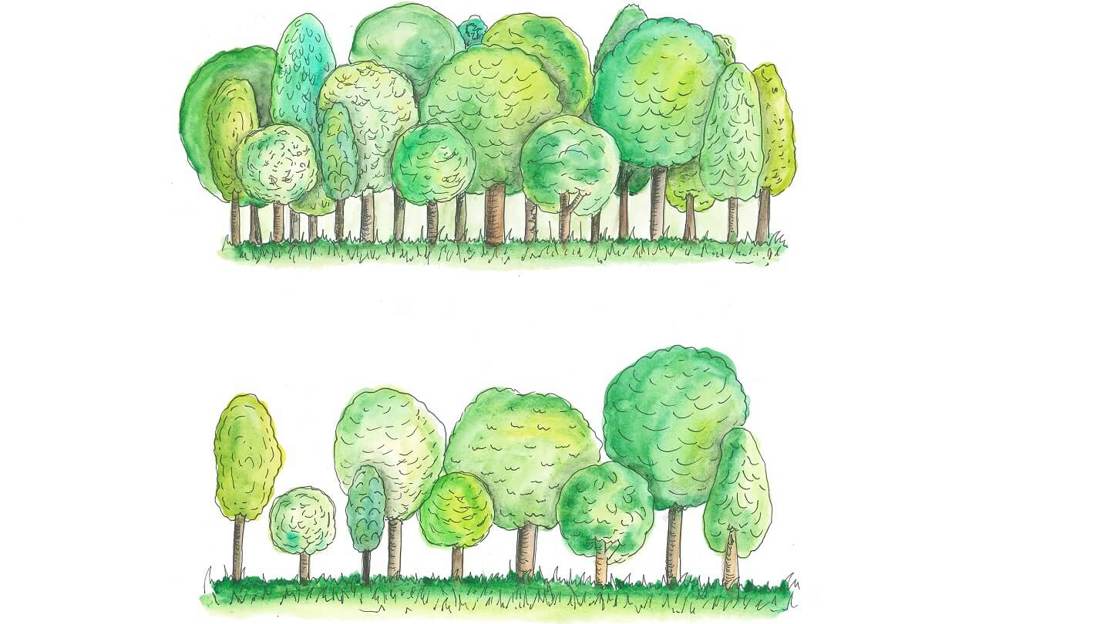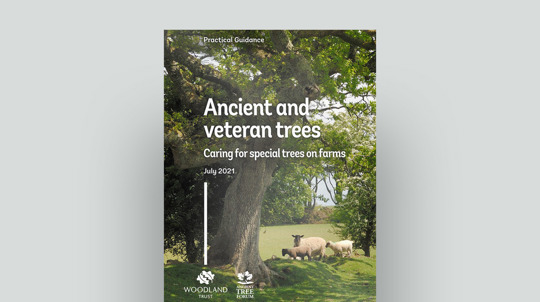Types of woodland management
A detailed look at how and when to carry out the techniques of coppicing, pollarding, formative pruning and thinning.
Coppicing
What is coppicing?
Coppicing is an ancient system of woodland management. Trees are cut close to the ground on a regular cycle. They regrow from dormant buds at the base of the stump (known as the stool) to create dense stands of multi-stemmed trees. The new stems grow back faster to provide a sustainable timber supply rather than harvesting more mature, thicker branches.
Which species can be coppiced?
Most native trees, but commonly oak, sweet chestnut, willow, lime, hornbeam, field maple, rowan, alder and hazel.
When to coppice
Start coppicing once trees are growing vigorously. This could be after 1-2 seasons but is usually 5-6 years (more in Scotland). The best time to coppice is late September to early March when trees are dormant. Frequency depends on species and products you want to create, for example:
- Hazel: 7 year cycle for hurdle making
- Sweet chestnut: 15 year cycle for fencing materials
- Oak/hornbeam: 15-25 year cycle for firewood and building materials.
How to coppice
- Cut single-stemmed trees as close to the ground as possible and already established stools as close to the previous cut as possible.
- Use any sharp tool suitable for the size of material you are felling. Make a clean cut without separating bark from the wood. The cut should be sloped to throw off water and avoid the stool rotting.
- To ensure a productive coppice, protect stools from browsing mammals. New shoots are attractive to deer, rabbits, hare and other livestock. To protect them:
- use branches left on the ground after cutting (lop and top) to pile on the coppice stool; be aware this may suppress regrowth or reduce the straightness of new stems.
- use lop and top to build “dead hedges” around groups of stools.
- put a 6 foot high fence in place for a minimum of 2 years, until new shoots are out of reach of browsing animals. You can rotate fencing to different coupes throughout your coppicing cycle.
Coppice woodland in blocks known as coupes. This allows light in to ensure coppice stools regrow. The coupe size should relate to the rotation length. Divide the woodland into equal blocks and coppice within each coupe on a one year cycle. Some well-formed trees can be left in each coupe to establish a ‘coppice with standards’ system. Leave a standard tree as a marker at each corner of the plot. These trees will become majestic features of the wood.
Pollarding
What is pollarding?
Pollarding is the regular cutting of upper branches to encourage regrowth of dense foliage at the top of the tree. The cut branches can be used for firewood, building materials and other coppice products. Pollarded branches were traditionally used for animal fodder. Opening up the canopy in this way increases woodland light levels and benefits ground flora while making it more productive for grazing.
Which species can be pollarded?
Willow, ash, beech, hornbeam, lime and holly are traditionally pollarded for tree fodder, but most native trees can be pollarded.
When to pollard
Make the first cut on a maiden tree in winter. Do this once the tree has grown above the height at which you want to maintain the pollard. It's best to do this when the tree is young, usually 5-15 years old. Larger trees can also be topped and established as pollards – success depends on the age, species and level of shading. Re-pollarding can be done in winter for firewood and building materials. Cut your trees to create tree fodder in summer on a short rotation.
How to pollard
Once the tree is the desired height, you can remove branches above the main trunk. Whether you remove some or all branches may depend on the species or required outcome for your tree. Species like ash or hornbeam may benefit from retaining some branch cover.
Use any sharp tool suitable for the size of material being removed. Make a clean cut, sloped to avoid rainwater causing rot and without separating bark from the wood. Cut all limbs close to the stem's base to create the pollard head. In subsequent years, cuts should be made just above the previous pollard level to retain those areas of growth.
Cut your tree so it is out of reach of any potential browsing animals:
- 1.2m for roe deer and sheep
- 1.5m for fallow deer
- 1.8m for red deer and goats
- 2m or more for large cattle
Formative pruning
What is formative pruning?
Formative pruning is the management of young trees in order to manipulate their shape as they grow. The desired shapes and methods of pruning depend on the tree species and your objectives. Select the best trees for harvesting early in the young woodland’s life and clearly mark them. The most valuable trees for timber have long, straight, branch-free stems.
Which species can be pruned?
Most native species, including alder, ash, lime, oak, plane, rowan and willow.
When to prune
The best time to remove live branches is in early spring, just before trees come into leaf so that wounds can begin to heal straight away. However, there are some exceptions:
- Walnut—prune in July and August, to avoid excessive bleeding from pruning wounds.
- Cherry—prune in July and August, to minimise risks of infection by bacterial canker and other diseases.
Do not prune any species during periods of very low temperatures or severe drought.
How to prune
Remove the side branches while they are small ensuring a good clean cut. This can be done with secateurs initially, but a long handled pruning saw will be needed eventually. To grow tall straight trees for timber, remove the side branches as the tree grows. This raises the crown and allows a long knot free trunk to develop. To manage an apple tree for fruit, prune to retain a low open crown to allow lots of sun onto the ripening fruit.
Thinning
What is thinning?
Thinning is the removal of some trees or parts of trees within woodland. As the trees reach 10-15 years old, they begin to compete for space, light and nutrients and growth starts to slow. Thinning makes sure that the best trees grow at the fastest rate, allowing a more diverse woodland structure and helping to futureproof the landscape.
Which species can be thinned?
Most native broadleaf trees can be thinned. Conifer species can also be gradually thinned out of plantation on ancient woodland sites, slowly increasing light levels and encouraging sensitive, native species to naturally regenerate.
When to thin
Thinning is usually done from year 10, when trees reach around 7m tall. Aim to thin about 20% of trees every five to eight years. Try to avoid bird nesting season.
How to thin
Select the best formed trees to keep and remove the surrounding trees, giving them more space to grow. Thinning is done gradually, removing a few trees every 5-10 years. Line thinning is a common option in more commercial woodlands – whole rows of trees are removed initially and then the remaining trees in the row are thinned later. If your young trees are planted close to existing mature trees, consider halo thinning - removing newer trees from around the mature tree so it is not out-competed by younger neighbours.
Take care not to damage the trees you want to keep. Once the trees’ diameter is greater than a baked bean tin at chest height, you might need to apply for a Forestry Commission felling licence.













